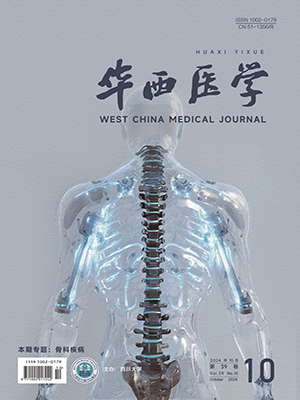| 1. |
Wang L, Xu X, Zhang M, et al. Prevalence of chronic kidney disease in China: results from the Sixth China Chronic Disease and Risk Factor Surveillance. JAMA Intern Med, 2023, 183(4): 298-310.
|
| 2. |
Yang C, Yang Z, Wang J, et al. Estimation of prevalence of kidney disease treated with dialysis in China: a study of insurance claims data. Am J Kidney Dis, 2021, 77(6): 889-897.
|
| 3. |
Snauwaert E, Van Biesen W, Raes A, et al. Haemodiafiltration does not lower protein-bound uraemic toxin levels compared with haemodialysis in a paediatric population. Nephrol Dial Transplant, 2020, 35(4): 648-656.
|
| 4. |
Wong J, Piceno YM, DeSantis TZ, et al. Expansion of urease- and uricase-containing, indole- and p-cresol-forming and contraction of short-chain fatty acid-producing intestinal microbiota in ESRD. Am J Nephrol, 2014, 39(3): 230-237.
|
| 5. |
Lemos DR, McMurdo M, Karaca G, et al. Interleukin-1 β activates a MYC-dependent metabolic switch in kidney stromal cells necessary for progressive tubulointerstitial fibrosis. J Am Soc Nephrol, 2018, 29(6): 1690-1705.
|
| 6. |
Kim HY, Yoo TH, Hwang Y, et al. Indoxyl sulfate (IS)-mediated immune dysfunction provokes endothelial damage in patients with end-stage renal disease (ESRD). Sci Rep, 2017, 7(1): 3057.
|
| 7. |
Kim HY, Yoo TH, Cho JY, et al. Indoxyl sulfate-induced TNF-α is regulated by crosstalk between the aryl hydrocarbon receptor, NF-κB, and SOCS2 in human macrophages. FASEB J, 2019, 33(10): 10844-10858.
|
| 8. |
Azevedo MLV, Bonan NB, Dias G, et al. p-Cresyl sulfate affects the oxidative burst, phagocytosis process, and antigen presentation of monocyte-derived macrophages. Toxicol Lett, 2016, 263: 1-5.
|
| 9. |
Shiba T, Kawakami K, Sasaki T, et al. Effects of intestinal bacteria-derived p-cresyl sulfate on Th1-type immune response in vivo and in vitro. Toxicol Appl Pharmacol, 2014, 274(2): 191-199.
|
| 10. |
Beaman M, Michael J, MacLennan IC, et al. T-cell-independent and T-cell-dependent antibody responses in patients with chronic renal failure. Nephrol Dial Transplant, 1989, 4(3): 216-221.
|
| 11. |
Juergensen PH, Finkelstein FO, Brennan R, et al. Pseudomonas peritonitis associated with continuous ambulatory peritoneal dialysis: a six-year study. Am J Kidney Dis, 1988, 11(5): 413-417.
|
| 12. |
Szeto CC, Chow VCY, Chow KM, et al. Enterobacteriaceae peritonitis complicating peritoneal dialysis: a review of 210 consecutive cases. Kidney Int, 2006, 69(7): 1245-1252.
|
| 13. |
Bossola M, Sanguinetti M, Scribano D, et al. Circulating bacterial-derived DNA fragments and markers of inflammation in chronic hemodialysis patients. Clin J Am Soc Nephrol, 2009, 4(2): 379-385.
|
| 14. |
Lin TY, Wu PH, Lin YT, et al. Gut dysbiosis and mortality in hemodialysis patients. NPJ Biofilms Microbiomes, 2021, 7(1): 20.
|
| 15. |
Ren ZG, Fan YJ, Li A, et al. Alterations of the human gut microbiome in chronic kidney disease. Adv Sci, 2020, 7(20): 2001936.
|
| 16. |
Luo D, Zhao W, Lin Z, et al. The effects of hemodialysis and peritoneal dialysis on the gut microbiota of end-stage renal disease patients, and the relationship between gut microbiota and patient prognoses. Front Cell Infect Microbiol, 2021, 11: 579386.
|
| 17. |
Wu IW, Lin CY, Chang LC, et al. Gut microbiota as diagnostic tools for mirroring disease progression and circulating nephrotoxin levels in chronic kidney disease: discovery and validation study. Int J Biol Sci, 2020, 16(3): 420-434.
|
| 18. |
Wu IW, Gao SS, Chou HC, et al. Integrative metagenomic and metabolomic analyses reveal severity-specific signatures of gut microbiota in chronic kidney disease. Theranostics, 2020, 10(12): 5398-5411.
|
| 19. |
Meijers BKI, De Preter V, Verbeke K, et al. p-Cresyl sulfate serum concentrations in haemodialysis patients are reduced by the prebiotic oligofructose-enriched inulin. Nephrol Dial Transplant, 2010, 25(1): 219-224.
|
| 20. |
Kelly JT, Palmer SC, Wai SN, et al. Healthy dietary patterns and risk of mortality and ESRD in CKD: a meta-analysis of cohort studies. Clin J Am Soc Nephrol, 2017, 12(2): 272-279.
|
| 21. |
Yamaguchi J, Tanaka T, Inagi R, et al. Effect of AST-120 in chronic kidney disease treatment: still a controversy?. Nephron, 2017, 135(3): 201-206.
|
| 22. |
Fujii H, Nishijima F, Goto S, et al. Oral charcoal adsorbent (AST-120) prevents progression of cardiac damage in chronic kidney disease through suppression of oxidative stress. Nephrol Dial Transplant, 2009, 24(7): 2089-2095.
|
| 23. |
Nakamura T, Sato E, Fujiwara N, et al. Oral adsorbent AST-120 ameliorates tubular injury in chronic renal failure patients by reducing proteinuria and oxidative stress generation. Metabolism, 2011, 60(2): 260-264.
|
| 24. |
Prakash S, Chang TMS. Microencapsulated genetically engineered live E. coli DH5 cells administered orally to maintain normal plasma urea level in uremic rats. Nat Med, 1996, 2(8): 883-887.
|
| 25. |
Lauriero G, Abbad L, Vacca M, et al. Fecal microbiota transplantation modulates renal phenotype in the humanized mouse model of IgA nephropathy. Front Immunol, 2021, 12: 694787.
|




